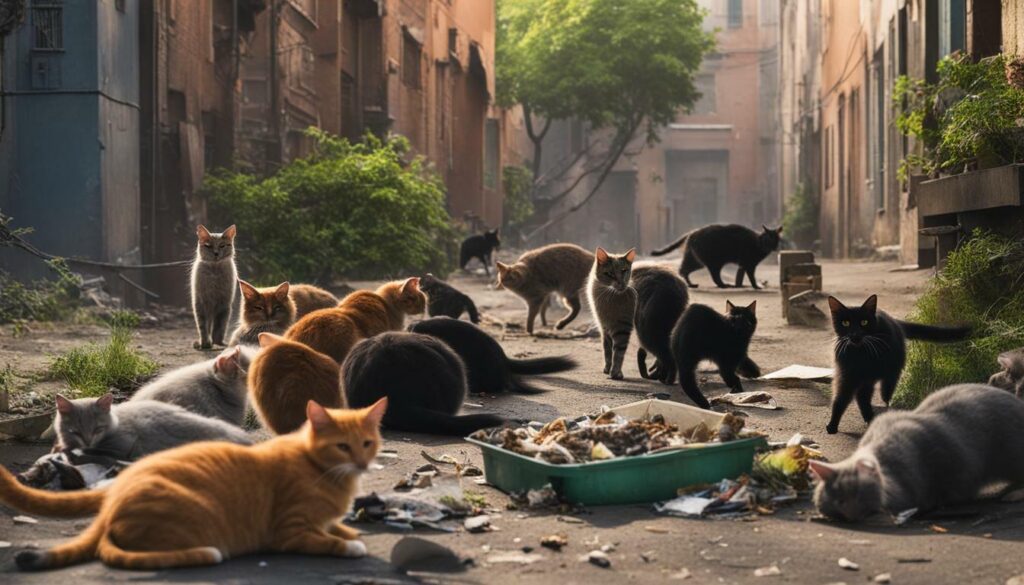Table of Contents
When it comes to pest control, many people immediately think of chemicals and pesticides. However, there’s a more natural and sustainable option available – stray cats. These feline creatures play a crucial role in maintaining a balanced ecosystem by controlling pests, and their impact on pest management is often underestimated.
Stray cats are natural hunters, and their instincts make them effective at controlling pests such as mice, rats, and insects. They are an eco-friendly option that reduces the necessity for harmful chemicals and pesticides, ensuring both a safe and cost-effective method of pest management.
Key Takeaways
- Stray cats play a critical role in natural pest control.
- They are effective at controlling pests such as mice, rats, and insects.
- Using stray cats as a form of pest management is eco-friendly and sustainable.
Understanding Pest Management
Pest management refers to the various techniques employed to control or eliminate pests. These techniques may include physical methods such as trapping or exclusion, chemical methods like pesticides, and biological methods such as using predators or parasites to control pests.
One effective method of biological pest control involves the introduction of feral cats to areas with pest problems. These cats are natural hunters and are able to target a wide range of pests, including rodents, insects, and other small animals.
Studies have shown that feral cats can be more effective at controlling pests than traditional pest control methods like pesticides. Additionally, feral cats offer a more sustainable and eco-friendly pest control option, as they do not rely on harmful chemicals and do not cause harmful environmental effects.
While feral cats may not be a total solution to all pest problems, they can certainly be a valuable and effective part of a larger pest management program. Their natural predatory skills make them an important tool in combating a wide range of pests in both urban and rural areas.
Stray Cats as Rodent Controllers
Stray cats have a natural instinct to hunt and prey upon various rodents that are considered to be pests in urban and rural areas. These rodents include mice, rats, voles, and squirrels. Due to their sharp reflexes and agility, cats have proven to be effective in controlling the local rodent population.
One of the advantages of using cats for rodent control is their ability to target specific areas where rodents are most active. For instance, cats can easily access alleys, basements, and backyards where rodents tend to thrive. This targeted approach ensures that the cats focus their hunting efforts where they are most needed, reducing the damage caused by rodents.
Additionally, cats as rodent controllers are a natural, chemical-free method of pest management. Unlike traditional pest control methods that rely on harmful chemicals and pesticides, cats provide a sustainable and eco-friendly solution for rodent control. Their presence in a neighborhood can prevent the need for toxic chemicals that can harm the environment and other wildlife.
Cats are also capable of hunting and capturing rodents that are resistant to traditional pest control measures. For example, some rat populations have become resistant to certain toxins, making it difficult for pest control professionals to eliminate them. By contrast, the natural instincts of cats make them effective at detecting and targeting these hard-to-control rodents.
In conclusion, stray cats are a valuable asset in controlling rodent populations in both urban and rural environments. Their natural hunting instincts and targeted approach make them an effective and eco-friendly form of pest management. By supporting local TNR programs, communities can harness the natural pest control abilities of stray cats while also providing them with the care and support they need.
Benefits of Cats as Pest Control
Using cats as a form of pest control offers numerous benefits, especially in comparison to traditional methods using chemicals and pesticides. Cats are a natural and sustainable solution that can effectively control pests while promoting ecosystem balance. Here are some of the benefits of using cats as pest control:
- Natural pest control: Unlike chemical pesticides, cats hunt and eliminate pests naturally, reducing the need for harmful chemicals that can harm both the environment and animals.
- Cost-effective: Employing cats for pest control is a low-cost alternative to traditional methods, which require costly chemicals and regular treatments.
- No environmental toxins: Since cats do not use toxic chemicals to control pests, they do not contribute to the accumulation of toxins in the environment or the food chain.
- Long-term solution: Using cats for pest control provides a long-term solution that does not require continuous treatments and routine maintenance as chemicals do.
- Protects other wildlife: Cats help protect other wildlife by controlling pests that could otherwise harm them and disrupt the natural balance of the ecosystem.
In short, using cats as pest control provides a sustainable and natural alternative to traditional methods that can be harmful to the environment and other animals. Harnessing the hunting abilities of stray cats not only controls pest populations but also preserves the delicate balance of ecosystems, contributing to a healthier planet.
Coexistence and Care for Stray Cats
Stray cats may be considered a nuisance in some communities, but they play an important role in maintaining natural pest control. It is crucial to coexist with these animals and provide care for them.
One way to manage stray cat populations responsibly is through local trap-neuter-return (TNR) programs. These programs trap stray cats, spay or neuter them, and return them to their communities. This method prevents the cats from reproducing while still harnessing their pest control abilities.
Supporting TNR programs can also ensure that stray cats receive proper medical care and food. This can reduce the likelihood of these cats resorting to scavenging through trash cans or hunting wildlife for survival.
It is important to remember that stray cats are not pets and can be unpredictable. It is recommended to not approach them or attempt to handle them. Instead, if there is a concern about a particular stray cat’s behavior, contact local animal control or a TNR program for assistance.
By coexisting with stray cats and providing care for them, communities can benefit from their natural pest control abilities while also promoting a healthy and balanced ecosystem.
Stray Cats and Ecosystem Balance
Stray cats play a crucial role in maintaining a balanced ecosystem by controlling the population of various pests. As natural hunters, they are particularly effective in targeting rodents such as rats and mice, which are common pests in both urban and rural areas. By reducing the population of these pests, stray cats help prevent the disruption of natural ecosystems and protect other wildlife.
Furthermore, using cats as a form of pest control offers a natural and sustainable method that reduces the reliance on harmful chemicals and pesticides. This not only benefits the environment but also protects human health by reducing exposure to potentially toxic substances.
To fully harness the pest control abilities of stray cats, it is important to coexist with them and provide care for them. Supporting local trap-neuter-return (TNR) programs is a responsible way to manage stray cat populations while still benefiting from their natural pest control abilities. When properly cared for, stray cats can continue to play a valuable role in maintaining a balanced ecosystem for years to come.
Conclusion
In conclusion, the role of stray cats in pest control cannot be overstated. These feline creatures offer a natural and sustainable method of pest management that reduces our reliance on harmful chemicals and pesticides. Stray cats are natural hunters and can effectively control rodents such as rats and mice, which are common urban and rural pests.
However, it is crucial to coexist with stray cats responsibly. Supporting local trap-neuter-return programs ensures that stray cat populations are managed effectively while still harnessing their pest control abilities. By doing so, we can maintain a balanced ecosystem and protect other wildlife.
Ultimately, stray cats are silent guardians in our communities, and it is important to appreciate and support their efforts in keeping pests at bay. As we strive for a more sustainable and eco-friendly future, we must remember the valuable role that stray cats play in our natural environment.



